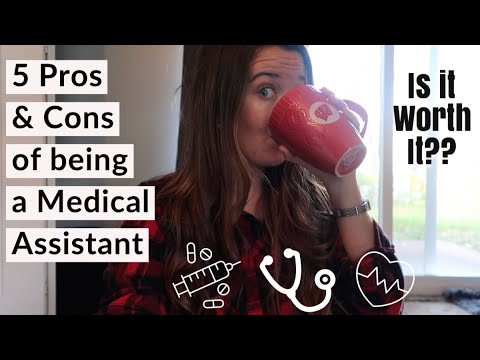What’s the Difference Between a PCA and a Medical Assistant?
Contents
- Job duties of a PCA vs. a medical assistant
- Training and education requirements
- Salary and job outlook
- PCA vs. medical assistant: which is right for you?
- The difference between a PCA and a medical assistant
- The duties of a PCA
- The duties of a medical assistant
- The training and education requirements for a PCA
- The training and education requirements for a medical assistant
- The salary and job outlook for a PCA vs. a medical assistant
If you’re wondering what the difference is between a PCA and a medical assistant you’re not alone. These two health care professions are often confused, but there are some key differences between them.
Checkout this video:
Job duties of a PCA vs. a medical assistant
A medical assistant is a multi-skilled professional who, under the supervision of a licensed health care provider, performs administrative and clinical tasks. Medical assistants work in ambulatory care settings such as physicians’ offices, group practices, and clinics. Their duties vary with the location, specialty, and size of the practice.
A personal care assistant (PCA) provides long-term care for people who are unable to independently care for themselves due to chronic illness, disability, or other conditions. PCAs help their clients with activities of daily living such as dressing, bathing, eating, and using the restroom. They also may provide light housekeeping services and transportation to doctor’s appointments or other errands.
Training and education requirements
The training and education required to become a PCA varies by state, but in general, it is less than what is required to become a medical assistant In some states, PCAs are required to complete a certified training program, which can last anywhere from several weeks to several months. In other states, there are no formal training requirements for PCAs, and individuals can learn the necessary skills on the job.
The education required to become a medical assistant also varies by state, but in most cases, Medical Assistants must have at least a high school diploma or equivalent. Some states also require medical assistants to complete an accredited postsecondary medical assisting program.
Salary and job outlook
The median salary for a medical assistant is $30,590 per year, while the median salary for a PCA is $28,860 per year. The job outlook for medical assistants is expected to grow much faster than average, at 23% through 2026. The job outlook for PCAs is expected to grow at a slightly slower rate of 17% during the same time period.
PCA vs. medical assistant: which is right for you?
The two most common positions in the medical field are the PCA and the medical assistant. But what’s the difference between the two, and which one is right for you?
The PCA (patient care assistant) is responsible for providing direct patient care under the supervision of a registered nurse. The PCA’s duties may include taking vital signs, providing baths, assisting with meals, and helping patients with their activities of daily living.
The medical assistant, on the other hand, is responsible for both clinical and administrative tasks. Medical assistants may perform such clinical tasks as measuring patients’ vital signs and recording their medical history. They may also administer injections and provide patient education. On the administrative side, medical assistants may schedule appointments, maintain medical records and code insurance forms.
Both the PCA and medical assistant positions require a high school diploma or equivalent, though some employers may prefer candidates who have completed a formal training program. Most states do not require certification for either position; however, some employers may prefer or require certification from an accredited organization such as the American Association of Medical Assistants (AAMA) or the National Healthcare Association (NHA).
If you’re interested in a career in healthcare but aren’t sure which position is right for you, consider your skillset and interests. Do you want to work directly with patients? If so, a career as a PCA might be a good fit for you. Do you want to perform both clinical and administrative tasks? If so, then a career as a medical assistant could be right up your alley!
The difference between a PCA and a medical assistant
The duties of a PCA and medical assistant are similar in many ways, but there are some key differences. A medical assistant typically has more clinical training than a PCA, and is therefore able to perform more complex medical tasks, such as taking vitals, administering injections, and performing basic lab tests. A PCA, on the other hand, provides more personal care to patients, such as bathing, dressing, and helping with meals. Both roles are important in providing quality care to patients, but the specific duties of each will vary depending on the needs of the individual patient.
The duties of a PCA
A PCA is a personal care assistant who helps patients with activities of daily living, such as bathing, eating, and dressing. A medical assistant, on the other hand, is a health care professional who performs both clinical and administrative tasks in a medical office. duties of a PCA can include helping patients with grooming tasks, transferring patients from their bed to a wheelchair, and providing support during physical therapy sessions. Medical assistants may also be responsible for scheduling appointments, taking patient medical histories, and performing basic laboratory tests. Although the duties of a PCA and a medical assistant differ, both positions require compassion and good communication skills.
The duties of a medical assistant
A medical assistant is a person who performs administrative and clinical tasks in a medical office. Medical assistants can perform a variety of duties, including taking medical histories, scheduling appointments, drawing blood, and giving injections. They also may help to answer patient questions, take care of billing and insurance matters, and order supplies.
A PCA (primary care assistant) is a medical assistant who has additional training in chronic disease management and preventive care. PCAs work with patients to help them control their chronic diseases, such as diabetes or hypertension. In addition to performing the duties of a medical assistant, PCAs may also teach patients about healthy lifestyles, provide case management services, and coordinate care with other health care providers.
The training and education requirements for a PCA
The training and education requirements for a PCA are much higher than for a medical assistant. A PCA must have at least an associate’s degree from an accredited college, while a medical assistant only needs a high school diploma or equivalent. In addition, a PCA must complete a certified nursing program and pass the NCLEX-PN exam, while a medical assistant is not required to have any formal education beyond high school.
The training and education requirements for a medical assistant
The training and education requirements for a medical assistant are different than those for a PCA. While a PCA only needs to complete a short period of on-the-job training, medical assistants must complete an accredited program and pass an exam. Medical assistants also have more responsibilities, such as taking medical histories and handling insurance paperwork.
The salary and job outlook for a PCA vs. a medical assistant
The average salary for a PCA is $29,770 per year, while the average salary for a medical assistant is $33,610 per year. The job outlook for a PCA is expected to grow by 11% through 2028, while the job outlook for a medical assistant is expected to grow by 29% during the same time frame.







